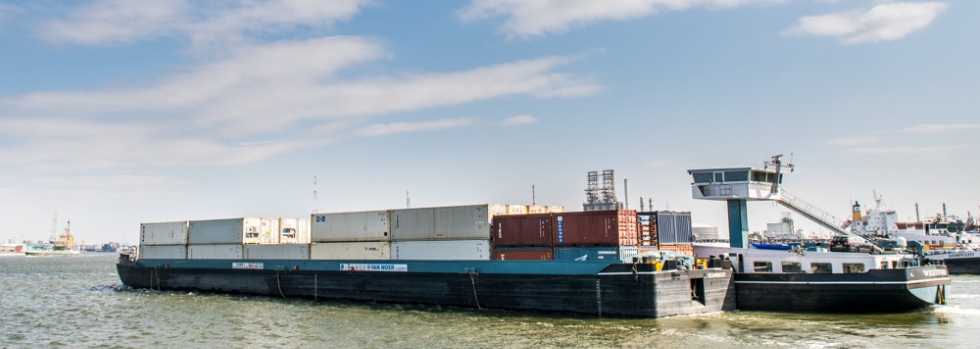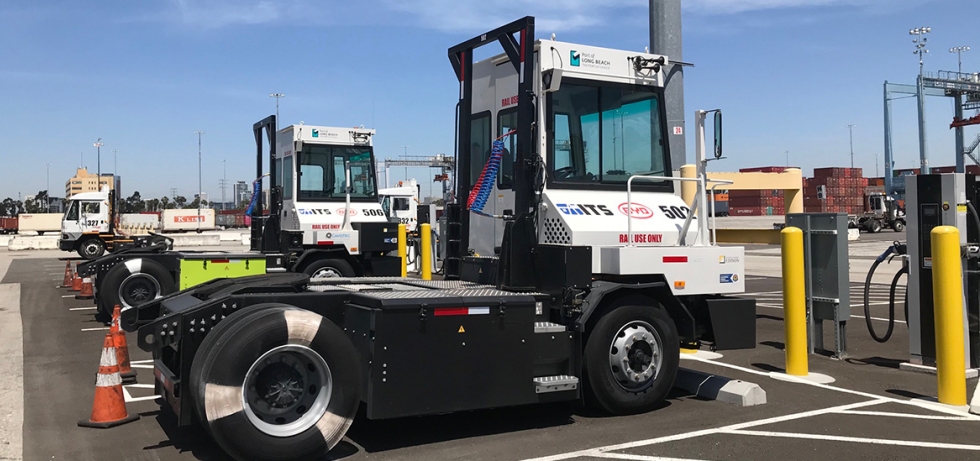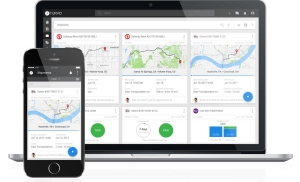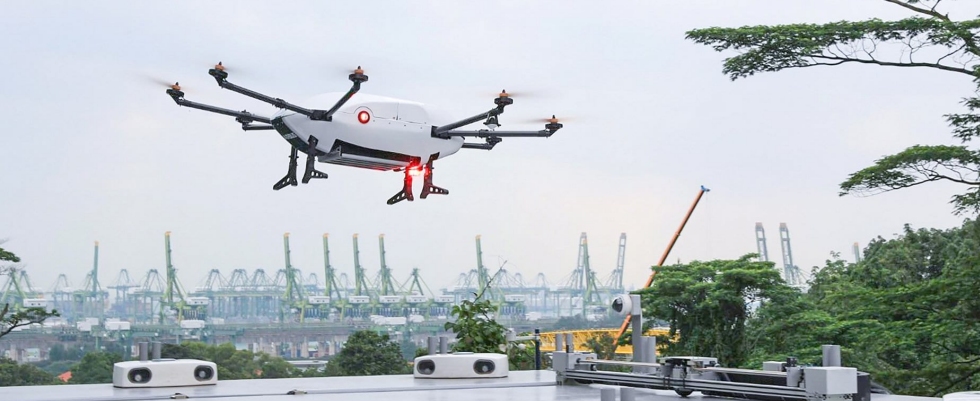|

UAntwerp and Port of Antwerp Testing Innovative Technology for Autonomous Shipping
3D sonar sensors enable unmanned sailing
Jan. 7, 2021 - Automated navigation is the future of inland shipping. It may sound futuristic, but innovative research carried out by UAntwerp and the Port of Antwerp is bringing us one step closer to this dream. The key: 3D sonar sensors, inspired by the way bats see the world.
“In 2019, over 42% of all goods entered or left the port of Antwerp via inland waterways,” says port alderman Annick De Ridder. “In other words, inland shipping is crucial if we want to ensure the accessibility of our city and our port. By focusing on technology such as unmanned navigation, we want to further increase both the market share and the competitiveness of inland shipping.”
“Unfortunately, inland shipping is not exactly a sexy sector,” says Svetlana Samsonova. As liaison officer, she coordinates many different joint research projects carried out by the University of Antwerp and the Port of Antwerp.
“Attracting young talent to this sector is not an easy feat. That's why we focus so strongly on innovation. Unmanned vessels can lead to substantial cost savings, as well as provide an answer to our increasing traffic congestion problems and the rising costs of road transport. Smart vessels definitely have a part to play in the multimodal transport approach that the Port of Antwerp wants to help develop further.”
Impervious to Dust and Fog
Enter Prof. Jan Steckel. At CoSys-Lab, a research group in UAntwerp's Faculty of Applied Engineering, he develops advanced sensor systems that can withstand harsh conditions.
“In order to achieve fully autonomous navigation, constant monitoring of the ship's surroundings is absolutely crucial,” Steckel explains. “Cameras can be used, of course, but when visibility is poor — due to dust, water sprays, mud, smoke or fog — they don't work properly.”
Sonar sensors, however, remain fully functional under such circumstances. They can provide a reliable picture of the ship's surroundings at a low cost. Steckel: “We drew our inspiration from the way bats use echolocation. They emit sound waves, and when those waves hit objects, the bats hear the echoes of these collisions, allowing them to avoid obstacles flawlessly.”
Reflected Sound Waves
CoSys-Lab is a world leader in innovative sonar technology, which has many possible uses. For instance, the researchers are also looking into applications in the mining industry, where trucks equipped with these sensors could drive automatically from point A to point B.
For the project with the Port of Antwerp, the researchers developed a 3D sonar sensor with 32 sophisticated waterproof microphones. The project is called eRTIS, which stands for 'embedded Real Time Imaging Sonar.’
Steckel: “The information is transmitted in real time, because if there are any delays, the ship could crash into something. The 'Imaging Sonar' part refers to reflected sound waves hitting the sensors to create a picture of the surroundings.”
In the last weeks of 2020, the technology was successfully tested on the Tuimelaar, one of the Port of Antwerp's test vessels. In 2021, there will be a follow-up project: as part of the Smart Docking Innovation Challenge, the Port of Antwerp has given the green light to Prof. Jan Steckel's 3D Sonar and Lidar for Vessel Monitoring project.
SOURCE: Port of Antwerp |
|
|

More Zero-Emissions Equipment Moving Cargo at Port of Long Beach
Oct. 8, 2020 - A container shipping terminal at the Port of Long Beach is now using new, zero-emissions cargo-handling tractors to test the readiness of the equipment to handle the workload at a busy seaport.
The terminal located at the Port’s Pier G is operated by International Transportation Service. ITS will demonstrate seven BYD battery-electric yard tractors for one year. Seven traditionally powered yard tractors annually emit 11 pounds of diesel particulate matter, 1,331 pounds of nitrogen oxides and 311 metric tons of greenhouse gases. International Longshore and Warehouse Union members are operating the vehicles.
“We need equipment that can make it through an entire shift, with recharging during breaks,” said Port of Long Beach Executive Director Mario Cordero. “That’s one of the requirements for zero-emissions equipment to demonstrate that it can function in a real-world environment. Alongside partners like ITS, we are leading the industry to a more sustainable future.”
The project is part of a $9.7 million grant awarded by the California Energy Commission, which involves the design or creation of 21 new or converted electric cargo handling vehicles. The grant will pay for most of the $13.7 million project intended to help commercialize vehicles that will move cargo sustainably at seaports all around the world and help the Port of Long Beach meet its goal of a zero-emissions cargo handling fleet by 2030.
“This project is an important step in realizing our Green Port aspirations,” said Long Beach Harbor Commission President Frank Colonna. “We would like to thank the California Energy Commission for their generous grant to help us clean our air and protect the communities around the harbor.”
ITS Chief Operating Officer Sean Lindsay said, “ITS is proud to participate in this Port of Long Beach demonstration featuring zero-emission technologies and concepts that will play a vital role in our industry’s future. In line with ITS’ company priorities, we’re continuing to take the proper steps in reducing our carbon footprint for the benefit of our waterfront community and goods movement.”
As part of the project, Southern California Edison also helped modernize the existing electrical infrastructure needed to support Port electrical equipment, worth approximately $450,000.
SOURCE: Port of Long Beach |
Turvo’s Logistics Platform Enables Entire Supply Chain to Work Together
 June 17, 2020 (FreightWaves) - Now five years into its journey, logistics startup Turvo is gaining traction, has landed a high-profile client for its product in Ryder System, and is focused on transforming what visibility means for a freight industry traditionally focused on silos. June 17, 2020 (FreightWaves) - Now five years into its journey, logistics startup Turvo is gaining traction, has landed a high-profile client for its product in Ryder System, and is focused on transforming what visibility means for a freight industry traditionally focused on silos.
“Visibility is not just a dot on the map, it’s how do you connect it to the organization,” Turvo founder Jeff Dangelo explained to FreightWaves. “There’s context around it. If this [delivery] is late, am I going to miss a sales deadline? It’s more than a blue dot [on a screen].”
Turvo is a “collaborative logistics platform” that is designed to bring order to chaos. It launched its logistics platform in 2017. The platform allows shippers, brokers and carriers to work together in real-time, providing shipment visibility, artificial intelligence (Al)-powered productivity tools, and secure collaboration, the company said.
"While other solutions focus on narrower aspects of logistics, such as on-demand trucking, freight forwarding, or track-and-trace of goods, Turvo spans the entire supply chain from orders and shipments to invoices and payments,” the company said at the time.
Dangelo said building the infrastructure that allows all parties to communicate seamlessly is harder than most people think.
“The network infrastructure is the hardest thing to start with,” he said. “You have to think who the audiences are you are starting with. It’s not just adding modules, but how will brokers, ports, truck drivers [and more] interact. They are all going to have their own views so when you build a solution, you have to think how [it is] going to be effective.”
Launched in 2015, Turvo received an initial $25 million in Series A financing led by Activant Capital, with participation from existing investors Felicis Ventures, Upside Partnership, Slow Ventures and Tony Fadell. In the summer of 2019, Turvo acquired ODYN, an AI-enabled visibility platform with the goal of accelerating the integration of connected sensors to its platform.
Just this month, Turvo was chosen by Ryder to backbone a new digital platform called RyderShare. The technology integrates data from multiple transportation and warehouse management systems into a single platform and allows all parties involved in a supply chain to easily see potential problems and inefficiencies and take real-time action to course correct, Ryder said.
According to Ryder, early customers have reduced emails and phone calls for an increase of up to 50% in productivity; a 35% labor efficiency savings with improved ability to plan receiving dock labor; and instant revenue recognition through document capture that includes real-time proof of delivery that reduces document delays by as many as five days. One customer, Ryder said, boosted its on-time performance rating from 95% to 99%.
Dangelo said the company now has 28,000 organizations interacting with Turvo’s solutions in some capacity, including nearly 1,000 companies like Ryder that are using the product as a key technology for their operation.
The full story is available at: www.freightwaves.com
SOURCE: FreightWaves |
|

Drones to Help Develop 5G for Ports; Maritime and Port Authority of Singapore Involved in Trials
June 15, 2020 - The Infocomm Media Development Authority (“IMDA”), M1 Limited (“M1”) and the Maritime and Port Authority of Singapore (“MPA”) have partnered with Airbus and to conduct coastal 5G standalone (“SA”) network trials at the Singapore Maritime Drone Estate. This continues Singapore’s efforts to build an open and inclusive 5G innovative ecosystem around the use cases of port operations, and incident management and response.
“M1 has been a front runner in supporting the maritime industry to drive adoption and application of smart 5G technologies, and we are very pleased to be working with IMDA and MPA to innovate more 5G use cases in a live environment,” said Mr. Manjot Singh Mann, Chief Executive Officer, M1.
IMDA, M1, MPA and Airbus plan to conduct 5G SA trials in real-world environments to ensure unmanned aerial vehicles can operate safely and efficiently during all phases of their flights, including operations in the designated drone-fly zones.
M1 will also be collaborating with TeamOne Technologies Pte Ltd, a local enterprise, to support the development of local capabilities within Singapore’s small and medium-sized enterprises. TeamOne aims to design and develop the world’s first aeronautical certified 5G SA communication modem for urban air mobility (“UAM”) operations. This 5G modem will be tested and optimised during the trials.
Ms Quah Ley Hoon, Chief Executive, MPA, said, “Given the growing need to create more efficient and sustainable solutions for the maritime industry, MPA supported the world’s first ship-to-shore drone delivery trial by Airbus and Wilhelmsen last year. We look forward to deepening the collaboration with Airbus and M1 to pilot innovative use cases for 5G technology in the maritime industry.”
In addition to the coastal trials, M1 and Airbus have also signed a Memorandum of Understanding to conduct connectivity trials for in-land areas. This will enable M1 and Airbus to address the growing interest in unmanned aircraft systems (“UAS”) for UAM for other industries.
All necessary permits and approvals will be sought from relevant agencies prior to the conduct of any flight trials.
SOURCE: Infocomm Media Development Authority |

COSCO Shipping Ports Completes Smart Port Trial
May 11, 2020 (Port Technology International) - COSCO Shipping Ports (CSP), the biggest terminal operator in the world, has announced the successful completion of a 5G-enabled, automated vehicle trial at the Port of Xiamen, describing it as a “constructive result” in the development of smart ports.
In a statement, CSP said it worked with China Mobile and Dongfeng Commercial Vehicle Co. to complete the trial, which took place on the 11 May 2020.
An automated guided truck delivered containers to the COSCO Shipping Rose, collected others that were being unloaded and drove them to the yard.
In doing so, it automatically avoided several obstacles on the road and completed a series of operations, including positioning itself accurately for the cranes and smoothly completing all processes.
To mark the event, CSP hosted what it called the ‘5G Driverless Enabled Smart Ports’ video conference, which was broadcast to six cities: Shanghai, Hong Kong, Beijing, Wuhan, Shiyan and Xiamen.
During this video conference, CSP and its partners signed a Letter of Intent for extending application at 5G+ smart port and provided an “implementation plan for domestic and international smart ports”.
In addition, they also agreed the “joint enterprise standard” of ‘Performance And Test Methods For Driverless Truck For Containers In The Ports’ – the first standard of performance and test methods for driverless truck for containers in the ports.
The joint enterprise standard is divided into four sections, namely: driving scene and driving behavior requirements, wireless communication and information security requirements, vehicle function and performance technical requirements, vehicle testing and test methods.
Each section contains scope of application of the standard, normal reference documents, terms and definitions of the standard and the specific technical performance requirements. Such standard is applicable to the development process of the intelligent network-connected automated system for driverless truck for containers in the ports.
SOURCE: Port Technology International |
|
|